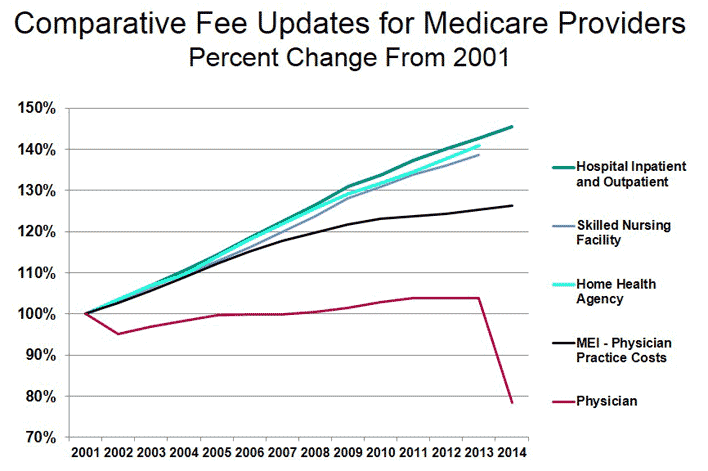Stop the Medicare Meltdown — repeal the SGR
Since the turn of the century, nothing has so regularly and completely vexed and frustrated physicians more than our annual game of chicken with Congress over Medicare payments.
Medicare patients and military families are never out of danger. Year after year, the specter of congressional action or lack of action threatens to jeopardize health care for Medicare patients. And, because TRICARE rates for military families are based on Medicare, they’re in danger, too.
This is because federal law requires Medicare payments to physicians to be modified annually using the Sustainable Growth Rate (SGR) formula. Because of flaws in how it was designed, the formula has mandated physician fee cuts every year for the past decade. Only short-term congressional fixes have stopped the cuts. In 2010 alone, Congress had to intervene five times to stop a 25-percent cut. It took emergency action in December 2011 and again in February 2012 to stop a 27.4-percent cut. That would have meant an annual loss of $1.71 billion to physicians for the care of elderly patients and Texans with disabilities.
Most commercial insurers pay physicians based on a percentage of the Medicare rate, which has changed little over the past decade. This double hit has meant a flat-lining of physician payment rates that threatens the viability of many physician practices and makes investment in new clinical equipment and health information technology increasingly more difficult and challenging.
Because Congress once again failed to repeal the SGR, the Congressional Budget Office projects that the next cut, scheduled for Jan. 1, 2013, will be 27.5 percent. Without a permanent solution, the size of the cuts continues to grow.
Instead of fixing the flawed formula, Congress freezes the cut each year. In essence, Congress has put the SGR debt on our credit card. The 10-year cost of fixing the problem is now well over $300 billion. [96]
Considering that Medicare currently pays, on average, at least 20 percent less than a physician’s cost to provide care, this decade-long and continued uncertainty is forcing some physicians to make the difficult decision to either opt out of Medicare, limit the number of patients they treat, or retire early. A recent TMA survey indicates that 50 percent of Texas physicians are considering opting out of the Medicare program altogether. [97]
Medicare patients often can’t get in to see their physicians as quickly as needed. This forces Medicare patients to put off care until they are so sick they need to use a hospital’s ED, which is more expensive. Sending a Medicare patient to the ED is counterproductive to the goal set by Congress and the White House to keep health care costs down by encouraging all Americans to have a “medical home.”
We all recognize the value that hospitals, nursing homes, home health services, durable medical equipment, and other health care providers give to Medicare patients. Over the past decade, they have received annual payment increases, while physicians have not.
Medicare patients should feel anything but secure about the future of their health care. Physicians are the foundation of the Medicare program. Without a robust network of physicians to care for the millions of patients dependent on Medicare, the program will not work.
